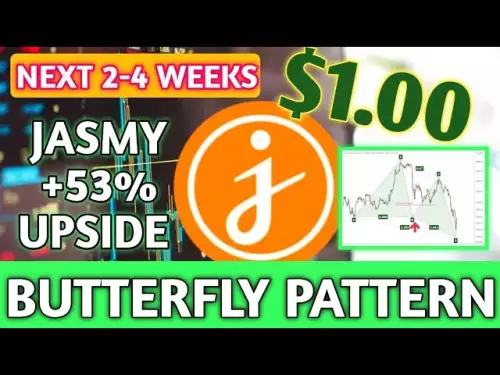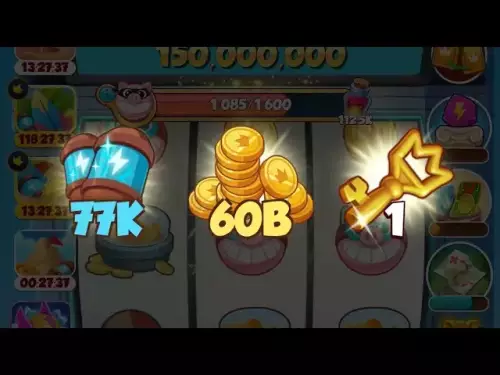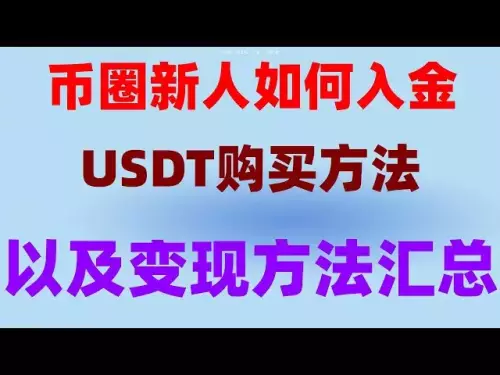-
 Bitcoin
Bitcoin $110300
-1.87% -
 Ethereum
Ethereum $4440
-5.77% -
 XRP
XRP $2.928
-2.35% -
 Tether USDt
Tether USDt $1.000
0.04% -
 BNB
BNB $846.6
-3.56% -
 Solana
Solana $189.5
-7.38% -
 USDC
USDC $0.9999
-0.01% -
 TRON
TRON $0.3451
-3.55% -
 Dogecoin
Dogecoin $0.2120
-6.80% -
 Cardano
Cardano $0.8440
-6.51% -
 Chainlink
Chainlink $23.36
-9.64% -
 Hyperliquid
Hyperliquid $45.37
-0.87% -
 Stellar
Stellar $0.3912
-2.88% -
 Ethena USDe
Ethena USDe $1.001
0.01% -
 Sui
Sui $3.427
-5.42% -
 Bitcoin Cash
Bitcoin Cash $541.9
-6.19% -
 Hedera
Hedera $0.2361
-3.53% -
 Avalanche
Avalanche $23.47
-6.78% -
 UNUS SED LEO
UNUS SED LEO $9.576
-0.13% -
 Litecoin
Litecoin $110.9
-4.17% -
 Toncoin
Toncoin $3.164
-3.92% -
 Shiba Inu
Shiba Inu $0.00001221
-4.42% -
 Uniswap
Uniswap $9.814
-8.21% -
 Polkadot
Polkadot $3.810
-5.78% -
 Cronos
Cronos $0.1600
0.16% -
 Dai
Dai $1.000
0.02% -
 Bitget Token
Bitget Token $4.507
-2.31% -
 Aave
Aave $332.1
-2.83% -
 Monero
Monero $265.5
-3.96% -
 Ethena
Ethena $0.6289
-6.04%
What are the most popular moving average combinations used by crypto traders?
Moving averages like the 9 & 21 EMA or 50 & 200 SMA help crypto traders identify trends and generate buy/sell signals across various timeframes.
Aug 04, 2025 at 09:15 pm
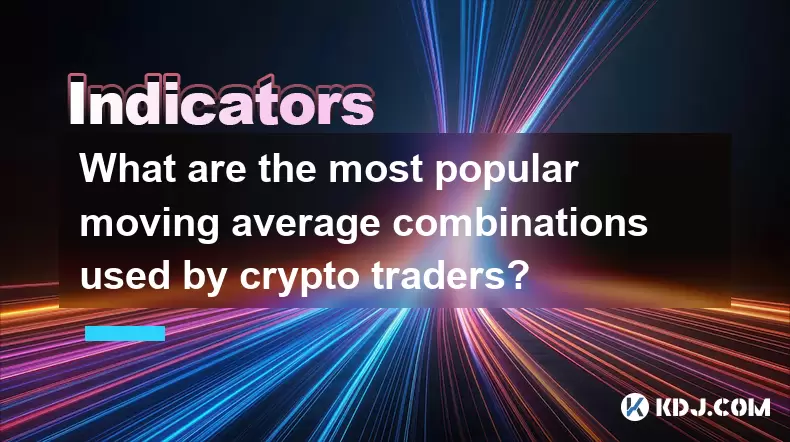
Understanding Moving Averages in Cryptocurrency Trading
Moving averages (MAs) are foundational tools in technical analysis, widely used by crypto traders to identify trends, gauge momentum, and generate buy or sell signals. A moving average smooths out price data over a specific time period, making it easier to spot directional movement. In the volatile world of cryptocurrencies, where prices can swing dramatically in short periods, MAs help filter out noise and provide clarity. The two primary types used are the Simple Moving Average (SMA) and the Exponential Moving Average (EMA). While the SMA gives equal weight to all data points, the EMA places greater importance on recent prices, making it more responsive to new information.
Common Dual Moving Average Crossover Strategies
One of the most popular techniques involves using two moving averages together—a shorter-term and a longer-term MA. When the shorter MA crosses above the longer one, it’s known as a golden cross, often interpreted as a bullish signal. Conversely, a death cross occurs when the shorter MA crosses below the longer one, signaling bearish momentum. The most widely adopted dual combinations include:
9 EMA and 21 EMA: This pairing is favored by short-term traders and scalpers due to its sensitivity. The 9-period EMA reacts quickly to price changes, while the 21-period EMA acts as a dynamic support or resistance level. When the 9 EMA crosses above the 21 EMA on a 4-hour or daily chart, it may suggest a good entry point for long positions.
50 SMA and 200 SMA: Known as the classic long-term trend indicator, this combination is used by swing and position traders. The 50-day SMA crossing above the 200-day SMA on a daily chart is a strong bullish signal, especially when confirmed by volume. This setup is frequently observed during major Bitcoin bull runs.
12 EMA and 26 EMA: These values are also the basis of the MACD (Moving Average Convergence Divergence) indicator. Traders use them independently to detect early momentum shifts. A crossover of the 12 EMA over the 26 EMA on a 1-hour chart can signal entry opportunities in altcoins with high volatility.
Triple Moving Average Systems for Enhanced Precision
To reduce false signals, many traders employ three moving averages instead of two. This system adds a middle-term MA to confirm trend direction before acting on crossovers. A popular triple combination is:
20 EMA, 50 EMA, and 100 EMA: This setup allows traders to assess short, medium, and long-term trends simultaneously. When the 20 EMA is above the 50 EMA, and the 50 EMA is above the 100 EMA, the market is considered in a strong uptrend. Entries are often taken when price pulls back to the 50 EMA and bounces, with all three MAs aligned upward.
9 EMA, 21 EMA, and 50 EMA: Commonly used on 4-hour and daily timeframes, this trio helps distinguish between retracements and reversals. If the 9 EMA remains above the 21 EMA, and both are above the 50 EMA, the trend is deemed healthy. A break below the 50 EMA may prompt traders to exit long positions.
Optimizing Moving Averages for Different Timeframes
The effectiveness of moving average combinations depends heavily on the trading timeframe. Day traders, for instance, rely on faster MAs to capture intraday movements, while long-term investors use weekly or monthly charts with slower MAs.
For 15-minute and 1-hour charts, combinations like 9 EMA and 18 EMA or 10 EMA and 30 EMA are effective. These settings adapt quickly to rapid price changes common in altcoins.
On 4-hour charts, the 20 EMA and 50 EMA combination is widely used. The 20 EMA acts as a trigger line, while the 50 EMA serves as a trend filter. A buy signal is stronger when price is above the 200 EMA and the 20 EMA crosses above the 50 EMA.
For daily charts, the 50 SMA and 200 SMA remain the gold standard. Institutional traders and crypto analysts frequently reference these levels when discussing market structure. A sustained price above the 200-day SMA is often seen as a sign of a bull market.
Customizing Moving Averages for Specific Cryptocurrencies
Not all cryptocurrencies behave the same, so traders often adjust moving average periods to suit individual assets. High-volatility altcoins may require smoother MAs to avoid whipsaws, while Bitcoin, with its relatively stable trends, responds well to standard settings.
For Bitcoin (BTC), the 11 EMA and 21 EMA on the 4-hour chart is a favorite among swing traders. The 11-period setting is less common but offers a balance between responsiveness and smoothness.
For Ethereum (ETH), the 10 EMA and 50 EMA combination on the 1-hour chart is frequently used. ETH tends to trend strongly during breakout phases, and this setup helps capture early momentum.
For low-cap altcoins, traders may use 15 EMA and 45 EMA to account for erratic price action. These settings reduce noise while still providing timely signals.
Practical Steps to Apply Moving Average Strategies on Trading Platforms
To implement these strategies on platforms like TradingView, Binance, or Bybit, follow these steps:
Log in to your preferred trading platform and open the chart for the cryptocurrency you’re analyzing.
Click on the “Indicators” button and search for “Moving Average.”
Add the first MA, selecting the type (EMA or SMA), period (e.g., 9), and color (e.g., green).
Repeat the process to add a second MA with different settings (e.g., 21 EMA, red).
Adjust the chart timeframe to match your strategy (e.g., 4H for swing trading).
Enable alerts for crossovers if the platform supports it, or manually monitor the chart.
Confirm signals with volume or RSI to reduce false entries.
Frequently Asked Questions
What is the difference between SMA and EMA in crypto trading?
The Simple Moving Average (SMA) calculates the average price over a set period with equal weighting for each data point. The Exponential Moving Average (EMA) gives more weight to recent prices, making it more sensitive to new information. In fast-moving crypto markets, the EMA is often preferred for its responsiveness.
Can moving averages be used in sideways markets?
Yes, but with caution. In ranging markets, moving averages may produce false crossovers, known as whipsaws. Traders often combine MAs with oscillators like Bollinger Bands or RSI to identify overbought or oversold conditions and avoid trading during consolidation.
How do I choose the right moving average periods for my strategy?
Start with widely used combinations like 9 and 21 EMA or 50 and 200 SMA. Backtest them on historical data for your chosen cryptocurrency and timeframe. Adjust the periods incrementally and evaluate performance based on win rate and risk-reward ratio.
Should I use closing price or typical price when calculating moving averages?
Most traders use the closing price, as it reflects the final consensus of value for the period. Some advanced strategies use the typical price ((high + low + close)/3), but this is less common in crypto. Stick with closing price unless you have a specific reason to deviate.
Disclaimer:info@kdj.com
The information provided is not trading advice. kdj.com does not assume any responsibility for any investments made based on the information provided in this article. Cryptocurrencies are highly volatile and it is highly recommended that you invest with caution after thorough research!
If you believe that the content used on this website infringes your copyright, please contact us immediately (info@kdj.com) and we will delete it promptly.
- Hong Kong Stablecoin Regulations: A New Era for Crypto?
- 2025-08-26 12:50:12
- Blockchain, Crypto, and Finance: Navigating the 2025 Bull Run
- 2025-08-26 13:05:13
- Bukedea School: From Local Hopefuls to East African Football & Beach Volleyball Champs
- 2025-08-26 13:05:13
- Scaramucci, Bitcoin, and a Touch of Romeo & Juliet: A Modern Crypto Romance?
- 2025-08-26 13:25:13
- USDC, USDT, and the Stablecoin Market: A 2025 Overview
- 2025-08-26 13:25:13
- Bitcoin, Holdings, Strategy: Decoding Strategy's Bold Play
- 2025-08-26 13:45:13
Related knowledge
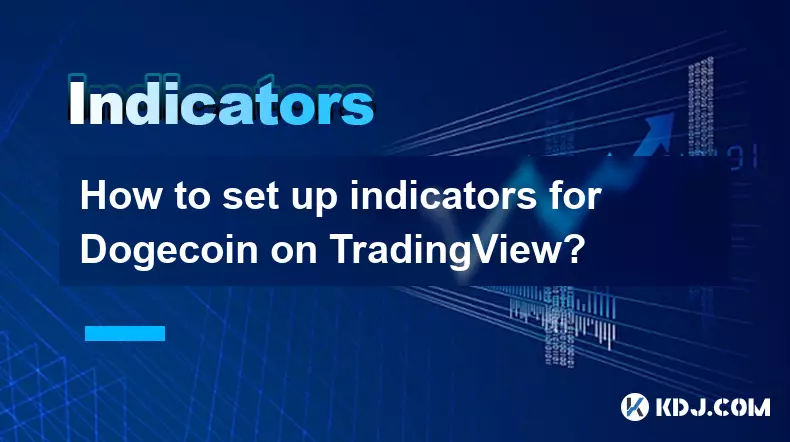
How to set up indicators for Dogecoin on TradingView?
Aug 25,2025 at 04:23pm
Understanding Dogecoin and TradingView1. Dogecoin, initially created as a meme-based cryptocurrency, has evolved into a widely traded digital asset. I...

What does it mean when the +DI and -DI cross frequently in the DMI indicator but the ADX is flattening?
Aug 11,2025 at 03:15am
Understanding the DMI Indicator ComponentsThe Directional Movement Index (DMI) is a technical analysis tool composed of three lines: the +DI (Positive...

What does the sudden appearance of a "dark cloud cover" candlestick pattern during an uptrend indicate?
Aug 13,2025 at 11:35am
Understanding the 'Dark Cloud Cover' Candlestick PatternThe dark cloud cover is a bearish reversal pattern in technical analysis that typically appear...

What does it mean when the moving average, MACD, and RSI all send buy signals simultaneously?
Aug 11,2025 at 01:42pm
Understanding the Convergence of Technical IndicatorsWhen the moving average, MACD, and RSI all generate buy signals at the same time, traders interpr...

What does it mean when both the KDJ indicator and the RSI show overbought signals simultaneously?
Aug 13,2025 at 11:35am
Understanding the KDJ Indicator in Cryptocurrency TradingThe KDJ indicator is a momentum oscillator derived from the Stochastic Oscillator, widely use...

What does it mean when the price is trading above the SAR indicator but the red dots are densely packed?
Aug 09,2025 at 11:49pm
Understanding the SAR Indicator and Its Visual SignalsThe SAR (Parabolic Stop and Reverse) indicator is a technical analysis tool used primarily to de...

How to set up indicators for Dogecoin on TradingView?
Aug 25,2025 at 04:23pm
Understanding Dogecoin and TradingView1. Dogecoin, initially created as a meme-based cryptocurrency, has evolved into a widely traded digital asset. I...

What does it mean when the +DI and -DI cross frequently in the DMI indicator but the ADX is flattening?
Aug 11,2025 at 03:15am
Understanding the DMI Indicator ComponentsThe Directional Movement Index (DMI) is a technical analysis tool composed of three lines: the +DI (Positive...

What does the sudden appearance of a "dark cloud cover" candlestick pattern during an uptrend indicate?
Aug 13,2025 at 11:35am
Understanding the 'Dark Cloud Cover' Candlestick PatternThe dark cloud cover is a bearish reversal pattern in technical analysis that typically appear...

What does it mean when the moving average, MACD, and RSI all send buy signals simultaneously?
Aug 11,2025 at 01:42pm
Understanding the Convergence of Technical IndicatorsWhen the moving average, MACD, and RSI all generate buy signals at the same time, traders interpr...

What does it mean when both the KDJ indicator and the RSI show overbought signals simultaneously?
Aug 13,2025 at 11:35am
Understanding the KDJ Indicator in Cryptocurrency TradingThe KDJ indicator is a momentum oscillator derived from the Stochastic Oscillator, widely use...

What does it mean when the price is trading above the SAR indicator but the red dots are densely packed?
Aug 09,2025 at 11:49pm
Understanding the SAR Indicator and Its Visual SignalsThe SAR (Parabolic Stop and Reverse) indicator is a technical analysis tool used primarily to de...
See all articles





















